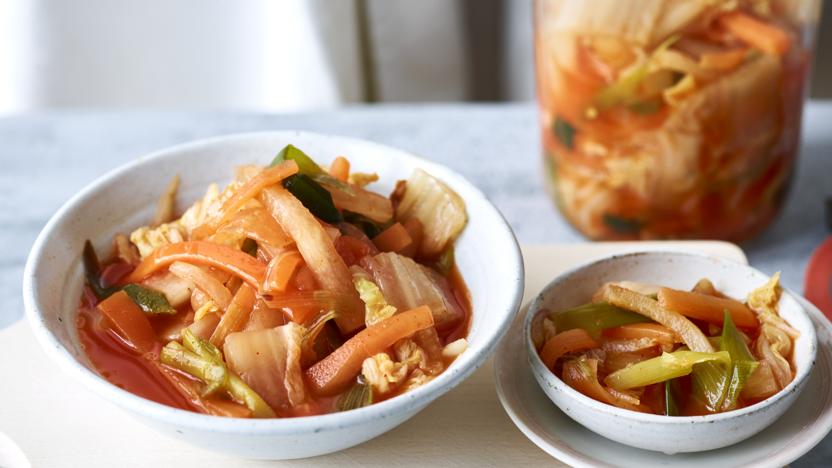Ching's homemade kimchi
Kimchi is the perfect accompaniment to noodle soups, rice dishes or as a spicy snack. Make this recipe to add to

Ingredients
- 1 head Chinese cabbage, 1-2 outer leaves reserved, remainder roughly shredded
- 30g/1oz sea salt
- ½ daikon (white radish or mooli), peeled and julienned
- 2 spring onions, trimmed and sliced into 5cm/2in pieces
- 2½cm/1in piece fresh root ginger, peeled
- 4 garlic cloves, peeled
- 2 small shallots, peeled
- 3 tbsp gochugaru (Korean red pepper flakes)
- 1 tbsp fish sauce
- 1 tsp caster sugar
- ½ tbsp glutinous rice power (optional)
Method
Wrap 1–2 of the cabbage leaves in damp kitchen paper and refrigerate until needed.
Place the shredded cabbage into a large, wide, deep pot or bowl. Add the salt and toss well. Pour in enough cool water to cover the cabbage and stir until the salt has dissolved. Place a plate over the bowl to fully submerge the cabbage in the salt water. Leave, at room temperature, for 6–8 hours or overnight (stir halfway through, if possible).
Drain the cabbage, reserving the brine. Rinse the cabbage well, and squeeze out any excess water, then return to the bowl. Add the daikon and spring onions.
Place the ginger, garlic, shallots, gochugaru, fish sauce, sugar and rice powder, if using, in a food processor. Pulse until the mixture forms a paste. Mix the paste with the cabbage and other vegetables using tongs or gloves, until well coated.
Tightly pack the mixture into a large, 1-litre sterilised jar, pushing it down well to ensure there are no air gaps, leaving 2.5–5cm of space at the top to allow for the juices that will be created (see the tips box for sterilising directions). Pour in enough of the reserved brine to just cover the vegetables, pressing them down a bit. Place the reserved cabbage leaves on top, pressing down, this helps to keep the kimchi submerged under the brine. You can also use a fermentation weight, if you have one, on top of the whole leaf.
Place the lid on loosely (to allow air to escape, or use a clip top jar) and place the jar in a deep baking dish or large bowl, to collect any juices. (The idea is to keep as much of the flavourful juice in the jar as possible, so resist the urge to overfill it!)
Leave the jar, out of direct sunlight, for 3 days. Press down on the kimchi daily with the back of a wooden spoon to keep everything submerged. After 3 days, the kimchi is ready to eat, but it won’t achieve its full flavour and complexity for about another 2 weeks. Tightly seal the jar with a lid and transfer to the fridge, where it will keep for months, as long as the kimchi is submerged in the brine.
Recipe Tips
Prepare your jar and lid shortly before you need them. You can do this by putting it through a hot (60C) dishwasher cycle shortly before you need it (don’t try to dry it with a tea towel, let it air dry) or wash it in hot water then place in an oven preheated to 140C/120C Fan/Gas 1 for 15 minutes (switch off the oven and leave the jar inside until needed). Alternatively, place the jar in a large stock pot with a clean folded cloth or trivet placed on the base, cover the jar completely with cold water and bring to simmering point (90C) for 10 minutes, next remove the pan from the heat and leave the jar in the hot water until you need it. When your kimchi is ready, carefully remove the jar from the pan, tipping out the water as you do so – a pair of bottling tongs makes this job easy, but otherwise use ordinary tongs.
Kimchi tastes best when fermented for longer than two weeks. Leave at room temperature for 3 days, then seal and refrigerate. It will keep for weeks in the fridge if the kimchi is fully submerged in brine.
To serve, scoop out the kimchi using a slotted spoon, transfer to a small side dish and dress with toasted sesame seeds. It is delicious on top of noodle soups, broths/stews or fried rice, or added to a stir-fry just before serving.

